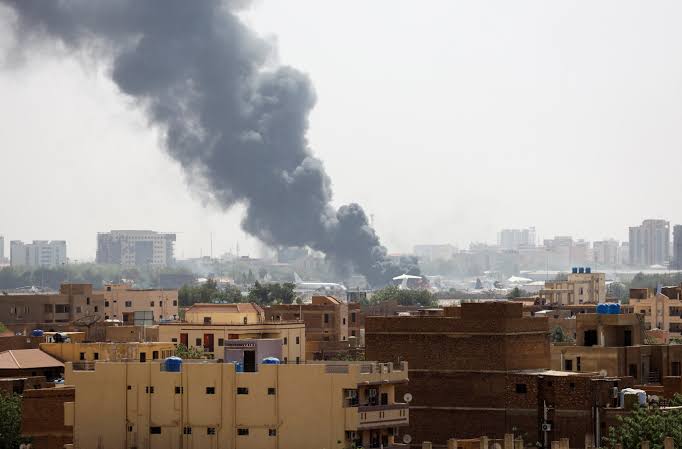Sudan’s conflict is causing alarm among its neighbours and other nations, which ranges from worries about the shared Nile and oil pipelines to worries about the makeup of a future government and the potential for a fresh humanitarian crisis.
Sudan, which is heavily dependent on international help, has experienced conflict before. The nation’s capital, which is located in a volatile area bordering the Red Sea, Sahel, and Horn of Africa, is currently being torn apart by conflict rather than a remote region.
Ethiopia, Chad, the Central African Republic, Libya, and South Sudan are the five of Sudan’s seven neighbours that have recently experienced political unrest or conflict.
Fighting broke out on Saturday in Khartoum between the army and the paramilitary Rapid Support Forces (RSF).
has scuttled a plan approved by the international community for the replacement of Omar al-Bashir in 2019 with a civilian government.
General Abdel Fattah al-Burhan, the chairman of Sudan’s ruling council and commander of its army, is engaged in combat with General Mohamed Hamdan Dagalo, also known as Hemedti, Burhan’s deputy on the council and commander of the irregular RSF forces. Hemedti is a wealthy former militia leader.
The history of Egypt, the most populous Arab nation, and Sudan are entwined by common Nile waters, politics, trade, and culture. Since the 2019 uprising that resulted in al-Bashir’s ouster, Cairo has been concerned about political instability in its southern region. Al-Burhan is friendly with Egyptian President Abdel Fattah el-Sisi, who similarly won election through a military coup.
With an estimated 4 million individuals, including 60,000 refugees and asylum seekers, Sudanese are by far the largest foreign group in Egypt.
The Grand Ethiopian Renaissance Dam upstream on the Blue Nile poses a threat to Egypt and Sudan’s freshwater resources, which both depend on the Nile for their supply. The two countries have worked to control how the Ethiopian dam is used. Any deterioration in relations between Cairo and Khartoum could thwart their efforts to reach an agreement.
The United Nations reports that since the most recent fighting started, some 20,000 more refugees have entered Sudan from its western neighbour Chad, which has already taken in about 400,000 internally displaced Sudanese from previous conflicts.
Chad is concerned that the issue would spread to the refugee-populated areas beyond the border. Most of them are from Darfur, and during the Darfur crisis, Chad was the target of cross-border assaults by Sudan’s Arab militias, the Janjaweed, which later evolved into the RSF. Refugees from Darfur and communities in Chad were ambushed by the raiders, who took their cattle and killed anyone who fought.
The government of Chad claimed to have disarmed 320 paramilitary personnel who had invaded its country on Monday.
In the nearby Central African Republic, the Wagner Group of Russia employs mercenaries who cause concern in Chad.
Following a protracted civil war, South Sudan broke away from Sudan in 2011, and now exports 170,000 barrels of oil daily through its northern neighbour.
However, South Sudan’s government claimed this week that fighting had already hampered logistics and transport links between the oilfields and Port Sudan. Analysts claim that neither side in the conflict in Sudan has an interest in disrupting those flows.
Sudan is also home to almost 800,000 South Sudanese refugees. Any large-scale return could complicate attempts to provide life-saving relief to the more than 2 million South Sudanese refugees who have fled their homes due to civil unrest.
Periodically, clashes break out along the disputed sections of the border between Ethiopia and Sudan. According to analysts, any side could use Sudan’s upheaval to advance their goals.
When conflict broke out in 2020 in Ethiopia’s northern Tigray region, tensions over the fertile but contentious Al-Fashqa border arose, which resulted in the displacement of more than 50,000 Ethiopians into already impoverished areas of eastern Sudan.
Given the tensions surrounding Sudan’s $4 billion Blue Nile dam, which Sudan claims could endanger its own Nile dams and its citizens, Ethiopia will also be keeping an eye on developments.
Periodically, clashes break out along the disputed sections of the border between Ethiopia and Sudan. According to analysts, any side could use Sudan’s upheaval to advance their goals.
When conflict broke out in 2020 in Ethiopia’s northern Tigray region, tensions over the fertile but contentious Al-Fashqa border arose, which resulted in the displacement of more than 50,000 Ethiopians into already impoverished areas of eastern Sudan.
Given the tensions surrounding Sudan’s $4 billion Blue Nile dam, which Sudan claims could endanger its own Nile dams and its citizens, Ethiopia will also be keeping an eye on developments.
The International Criminal Court had accused al-Bashir of committing genocide and war crimes during the Darfur crisis, and the United States, along with other Western nations, were glad to see him go.
However, detractors claim that Washington took too long to support the transition to elections. As a result of the coup led by al-Burhan and Hemedti in 2021, Sudanese expectations for democracy were dashed.
Because neither of the two sides in Khartoum is displaying any signs of being willing to make concessions, the most recent fighting is predicted to stall any quick transition back to civilian rule.















